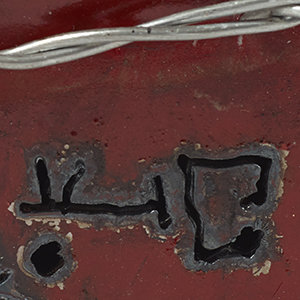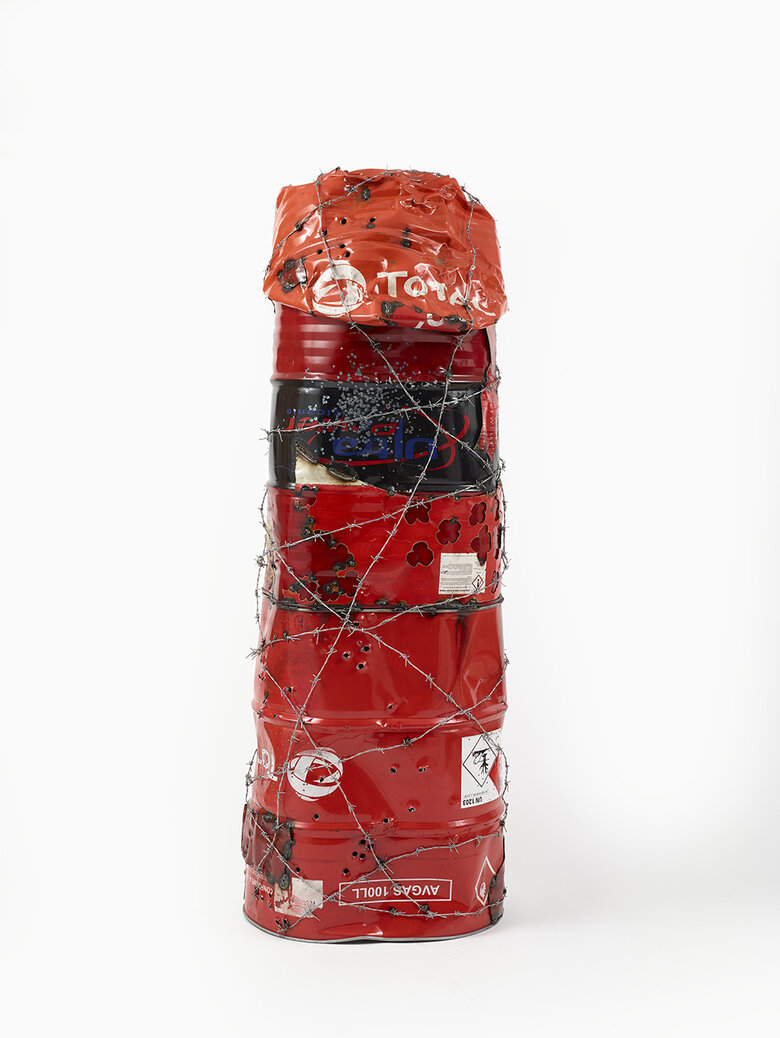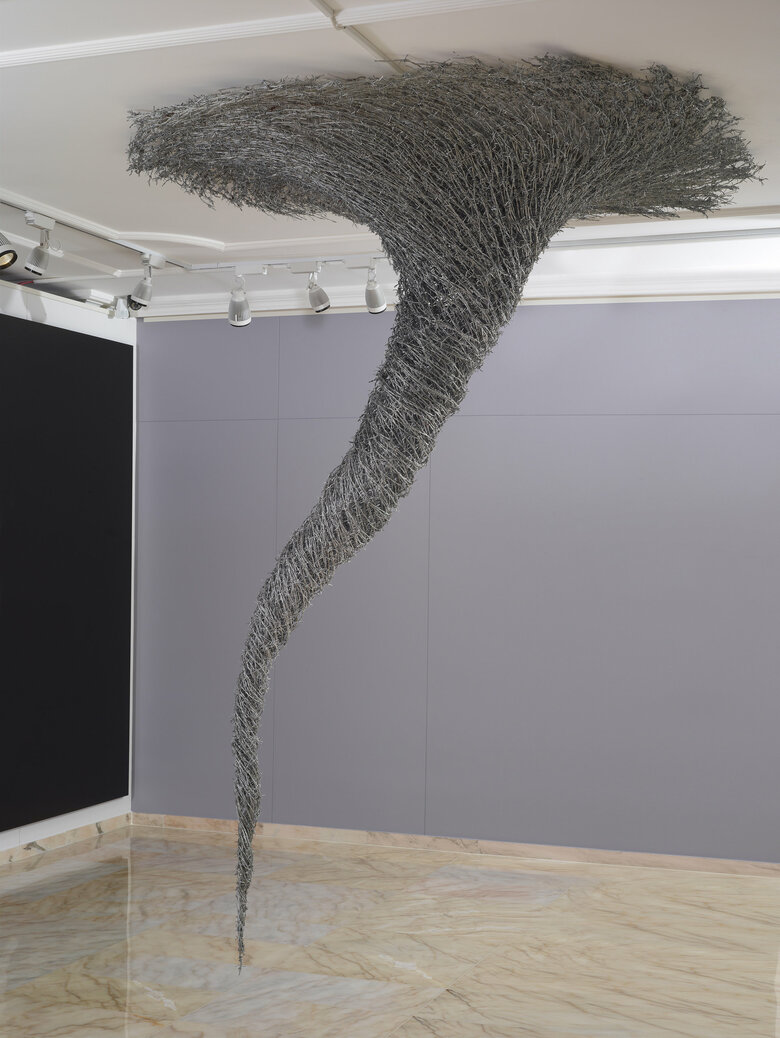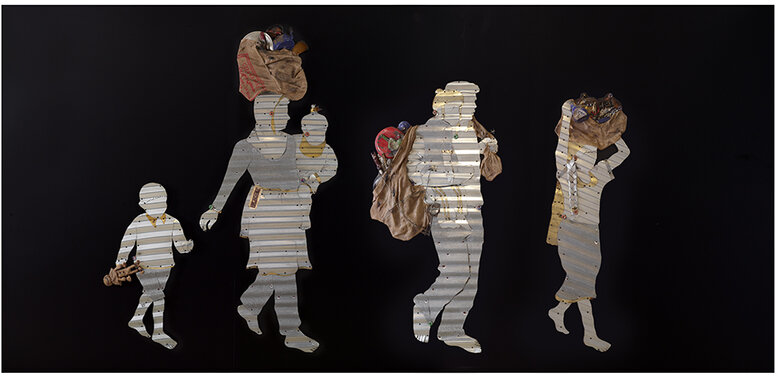Abdul Rahman Katanani, a Palestinian contemporary visual artist, was born in 1983 in the Sabra refugee camp in Beirut, Lebanon. After the 1948 Nakba, his grandparents fled their hometown on...


ABDUL RAHMAN KATANANI, Palestine (1983)
Bio
Written by WAFA ROZ
Abdul Rahman Katanani, a Palestinian contemporary visual artist, was born in 1983 in the Sabra refugee camp in Beirut, Lebanon. After the 1948 Nakba, his grandparents fled their hometown on Palestine, Jaffa, and settled in the Shatila refugee camp in Beirut. A third-generation refugee, Abdul Rahman, was raised in the Sabra refugee camp. He acquired his formative education at al-Makassed private school in Beirut, then at a UNRWA[1] run school in the camp. As of age eight, until college, Abdul Rahman worked alongside his father, a carpenter. He received his diploma in Fine Arts from the Lebanese University in Beirut in 2007 and an MFA in 2012 on Palestinian contemporary art. Between 2008 and 2012, he was a supervisor for the creative department at Al-Quds TV in Beirut. In 2012, La Cite des Arts foundation in Paris granted Katanani a three-month artist residency, later followed by a fifteen-month artist residency in 2013 and a three-month artist residency in 2016. Similarly, in 2017, Vent des Forests contemporary art center in Meuse, France, offered Katanani a two-months artist residency.[2]
Katanani was born into a world of poverty and trauma. A year before his birth, in September 1982, and following the Israeli invasion of Lebanon, a Lebanese Christian militia, committed one of the most horrifying massacres against the Palestinians in the Sabra and Shatila camps. In collaboration with the Israeli army, nearly two thousand refugees, mostly women, children, and the elderly, were slaughtered. “Two of my aunts lost their husbands in the massacre,” says Katanani. “They still don't know what happened to the bodies, and a lot of my family’s friends were also killed," he explains. His parents had escaped the camp couple of days earlier. His grandfather, however, refused to leave the only home he had left. [3]
Like many other Palestinian refugees, Katanani’s grandfather held on his “right of return” to Palestine. However, to date, no Palestinian has ever been granted that right. Hundreds of thousands of Palestinian refugees were dispersed across refugee camps in Lebanon. Camps were unliveable spaces: they lacked sustainable infrastructure, health or education services, or any decent employment opportunities. The Lebanese government also denied Palestinian social and economic rights. [4]
Despite these dire conditions, Katanani did not grow up to be bitter or nihilistic. Katanani reached for art and education to express his frustration, but with a positive and forward-looking outlook on life. The agile artist believes in cultural interaction and boundary crossing via art. His body of work, which spans from caricature and street-art to sculpture, and installation, addresses themes such as displacement, borders, trespassing, and freedom. Palestine is omnipresent in Katanani’s work and has come to serve as an allegory for all the displaced in the world.
To keep his hopes, during his teens, Katanani painted colorful graffiti murals in the refugee camp. He tagged whimsical graffiti texts and painted nationalist iconographic figures such as al- fida’i, the freedom fighter, and the dome of the rock. In 2004, to encourage communal art and give life to the camp, Katanani and a group of young refugees painted more than ninety murals on the walls of the Sabra refugee camp.[5] In addition to graffiti, Katanani illustrated numerous caricatures inspired by the Palestinian political caricaturist, Naji El-Ali. Katanani addressed the Palestinian cause in a non-violent form.
From the start, Katanani’s style was unorthodox. It ascribed to liberal ideals that pushed the artist to an even more expressive art form. Between 2008 and 2010, he created a collection of assemblages incorporating zinc metal sheets, kitchen utensils, pre-used garments, and laundry pegs; all materials collected from the camp. At first sight, the materials seem like scraps, but, for him, they represent the survival kit of a refugee: shelter, food, and clothing. At times, to enliven the picture, he would add touches of colorful spray-paint onto the final composition, such as in his picturesque assemblage entitled The Martyred Camp, 2008.[6] It features a mass of vibrant fabrics, a kufiyah, and laundry pegs spread and swirled around a human figure cut out of a corrugated zinc-metal sheet. Although his work resonates with the frameless fabric paintings familiar to the Supports/Surfaces[7]art movement and the ready-made objects found in installations of the Nouveau realism art movement[8], Katanani’s chaotic art is not pegged to any of those movements. Still, Katanani admires the art of abstract expressionist Robert Rauschenberg and nouveau réaliste Armand Fernandez or Arman.
Onto his metal cut-out figures, Katanani often places Pepsi-Cola bottle caps at the intersection of body parts, mainly joints. It is drawn from a childhood experience. As a kid, he helped his father install roofs made of corrugated zinc-metal sheets on top of the concrete cubicles of refugees. In the place of proper metal bolts, which they lacked, they used Pepsi-Cola bottle caps at the points of fixation and pinned a nail in the center of each bottle cap, hoping to keep the roof stable.
One of Katanani’s sources of inspiration is the children of the Sabra refugee camp. In the narrow, humid, and crowded alleyways, children made toys from trash. Katanani played with the kids and took pictures of them. He cut their enlarged pictured figures’ silhouettes out of corrugated zinc metal sheets. Onto these figures, he introduced accessories such as a red ribbon, a red cap, a blue skirt, or a green jumping bag cut out of flattened crude-oil barrels found in junkyards.
For instance, in After Six Days And We Will Be Back Inshallah (God willing), 2011,[9] a poignant artwork made mostly of silver corrugated zinc sheets, Katanani assembles his figures in a wall-mounted installation comprised of four pieces. The installation features a migrating family of six. A young boy follows his mom and dad while each carries a toddler. A grown-up girl in front leads the way. The adults hold on their shoulders and over their heads bags made of hessian cloth and stuffed with supplies and kitchen utensils. Touchingly, on the father's waist, a set of keys dangle – a hint to the right of return. Katanani's refugees are still and faceless. While they bear their uncertain future, they are made of metal sheets.
In his ‘kids and barbed wire’ genre of installation of 2011-2017, Katanani introduces barbed wire into his work and drops the application of paint. He sticks to the original metallic colors of crude oil barrels, such as red, blue, and green. Katanani often applies acid to the polished silver zinc-metal sheets toning down their glossy effect.[10] However, he doesn't mind the shiny surfaces of the once priceless crude oil barrels. In some compositions with kids playing, Katanani positions a wire to look like a jumping rope or a kite’s thread. At times he weaves the barbed wires into a large round disc and displays it as a carpet on which kids lie-down.
In the early stages of Katanani’s career, the materials drove the themes. With time, his themes became more focused, and materials were deliberately chosen. One thing remained constant, though; Katanani never departed from metal. As Katanani expresses, "I am one with metal […] the contrast between soft and hard, malleable and thorny, inspires me, specifically in barbed wire.” Barbed wire was his way of describing the contentious livelihoods of refugees or migrants.
Recently and following the Syrian refugee crisis, Katanani turned to broader issues of migration to Europe by sea. This topic is poignantly expressed in a collection of wave-like sculptures symbolic of the sea. Made out of one substantial curved piece of woven barbed wire, they range from two to eight meters in length. Moreover, Katanani expresses the state of being “stuck in a void without knowing what the future holds,” as he says, in tornado-like sculptures. Tornado, 2015[11] is a staggering ceiling mounted installation handmade of woven barbed wire. The three meters high and two hundred kilograms rotating column stands five cm above the ground and spirals from narrow to wider rims. The massive scale and dynamic rippling and spiral visual effect, in both the wave and the tornado suggest an urge for change or possibly revolt. Besides, both artworks are executed with a provocative material symbolic of restriction.
Boundaries, physical or otherwise, are a recurrent theme in Katanani’s art practice. Based on a past solo show entitled No Address, exhibited at L’Institut Francais in 2012, in Beirut, Katanani constructed a large-scale structure that mimics the refugee camp, which was displayed at his latest solo show Brain Storm in 2019, at Saleh Barakat Gallery, in Beirut. Katanani created a real-life model of the overcrowded and tight spaces of refugee camps, in which people were barely recognizable. The three meters high immersive installation with doors, windows, and alleyways is made out of colorful flattened crude oil barrels, silver corrugated metal sheets, brass ghee butter gallons, and wooden studs. The viewer’s gaze roams through the claustrophobic narrow pathways of the installation, and mirrors linings on both sides of the main corridor make viewers see their reflection. However, out of what apparently seems like a closed circuit, Katanani draws a way out breaking free from the camp’s borders and tight pathways.[12]
In other politically inspired projects, Katanani takes the facial silhouettes of prominent authoritarian Arab political figures and carves them out of crude oil barrels. The collection includes king Abdel Aziz Al Saud, Muammar Gaddafi, Gamal Abdel Naser, Mohammad Mosaaddagh, and Saddam Hussein, amongst others. Some of those political leaders funded political projects that threatened the rights of Palestinians. This mélange also hints to the centrality of petrodollars and the rentier state in the Middle East.[13]
After receiving a French passport in 2019, Katanani now lives between Paris and Beirut. The refugee boy who lived at, and worked all his life from the Sabra and Shatila refugee camps, “made a dream come true,” as he puts it. He recently moved with his parents and sisters to a new place in Dibieh, a Lebanese village in the Chouf district mountains. He built a new studio there, but his Sabra studio still remains too.
Notes
[1] UNRWA: United Nations Relief and Work Agency.
Katanani, Abdulrahman. (artist), interviewed by Wafa Roz.May 7,2020.
[2] Katanani, Abdulrahman. (artist), interviewed by Wafa Roz.May 7,2020.
[3] https://www.newsdeeply.com/refugees/community/2017/09/15/the-forgotten-refugees-survivors-of-the-sabra-and - Shatila- massacre
https://blogs.timesofisrael.com/why-the-world-cares-about-1982-sabra-and-shatila-massacre/
https://www.un.org/press/en/2015/gaspd599.doc.html
[4] “Palestinians Remain among Most Marginalized Refugees, Due to Israel's Occupation, Lack of Predictable Funding, Fourth Committee Told | Meetings Coverage and Press Releases.” United Nations, United Nations, www.un.org/press/en/2015/gaspd599.doc.htm.
[5] Globe Reporters. “Les Camps De Réfugiés Inspirent Le Palestinien Abdel Rahman El Katanani.” Globe Reporters, 19 Sept. 2016, www.globe-reporters.org/campagnes/liban/culture-et-francophonie/article/les-camps-de-refugies-inspirent-le-palestinien-abdel-rahman-el-katanani.
[6] “The Martyred Camp,2008
assemblage was shown in Abu Dhabi Biennale in 2009.”
“Abdul Rahman Katanani Catalogue ”In Early Works, 7, Saleh Barakat Gallery, Salim Dabbous Printing, Beirut, Lebanon, 2020.
[7], " Supports/Surfaces is a French art Movement (1966-1976). This group of artists […] produced work marked by an interest in materiality, lyrical use of color, and expansive ideas of what constitutes a painting.” They separated the canvas from the wooden stretcher.
The Painting Undone: Supports/Surfaces - Art critical ...artcritical.com/2004/02/01/the-painting-undone-supportssurfaces/.
[8] “Nouveau Réalism was founded in 1960 by the critic Pierre Restany, artists associated with nouveau réalism made extensive use of collage and assemblage as well as painting.”
Nouveau Réalisme – Art Term | Tate. www.tate.org.uk/art/art-terms/n/nouveau-realisme.
[9] The installation After Six Days And We Will Be Back Inshallah, 2011, is found at DAF Foundation, Beirut, Lebanon.
[10] Katanani, Abdulrahman. (The artist), interviewed by Wafa Roz.May 7,2020.
[11] The installation Tornado, 2015, is found at DAF Foundation, Beirut, Lebanon.
[12] Star, Maghie Ghali| The Daily. “Art Protesting Petrol and Poverty.” The Daily Star Newspaper - Lebanon, www.dailystar.com.lb/ArticlePrint.aspx?id=496878
Gasparia, Natasha, "Abdul Rahman Katanani Catalogue," In Of Metal and Mortar, 67-73.
Saleh Barakat Gallery, Salim Dabbous Printing, Beirut, Lebanon, 2020.
[13] Star, Maghie Ghali| The Daily. “Art Protesting Petrol and Poverty.” The Daily Star Newspaper - Lebanon, www.dailystar.com.lb/ArticlePr...
Sources
“Abdul Rahman Katanani - Hard Core - Magda Danysz.” Accessed May 9, 2020. http://magdagallery.com/eng/publication/14396/hard-core.
Accessed May 9, 2020. http://www.agialart.com/Artists/Details/26/Katanani-Abdul-Rahman.
Ayad, Myrna. “Migrant Crisis Finds Resonance in Palestinian Refugee Abdel Rahman Katanani's Work,” September 14, 2015. https://www.artsy.net/article/artsy-editorial-migrant-crisis-finds-resonance-in-palestinian-refugee-abdel-rahman-katanani-s-work.
Barakat, Saleh. Abdul Rahman Katanani. BEIRUT, BEIRUT: Saleh Barakat Gallery, 2020.
“Biography - Abdul Rahman Katanani.” Accessed May 9, 2020. https://www.abdulrahmankatanani.com/biography/.
Dabbagh, Jimmy. “Repurposing Displacement as Art.” Accessed May 9, 2020. http://ftp.dailystar.com.lb/Arts-and-Ent/Culture/2015/May-20/298565-repurposing-displacement-as-art.ashx.
Donner, Christophe. “Toute La Lumière Sur Katanani,” April 13, 2012. https://www.lemonde.fr/m-styles/article/2012/04/13/toute-la-lumiere-sur-katanani_1684318_4497319.html.
Figaro_Culture. “La Fabuleuse Histoire D'un Artiste Palestinien à Paris,” October 15, 2012. https://www.lefigaro.fr/arts-expositions/2012/10/15/03015-20121015ARTFIG00526-la-fabuleuse-histoire-d-un-artiste-palestinien-a-paris.php.
“Genève Blog: Interview Adbul Rahman Katanani,” May 4, 2020. https://mybiggeneva.com/abdul-rahman-katanani-interview/.
Globe Reporters. “Les Camps De Réfugiés Inspirent Le Palestinien Abdel Rahman El Katanani,” September 19, 2016. http://www.globe-reporters.org/campagnes/liban/culture-et-francophonie/article/les-camps-de-refugies-inspirent-le-palestinien-abdel-rahman-el-katanani.
Laylin, Tafline. “Powerful Scrap Sculptures Depict Life in Beirut's Shatila Refugee Camp,” March 27, 2014. https://www.greenprophet.com/2014/03/powerful-scrap-sculptures-depict-life-in-beiruts-shatila-refugee-camp/.
“Naji Al-Ali.” Accessed May 9, 2020. https://www.paljourneys.org/en/biography/14303/naji-al-ali.
Neslen, Arthur. In Your Eyes a Sandstorm: Ways of Being Palestinian. Berkeley, CA: University of California Press, 2011.
“Removing Barriers and Building Bridges: How Play Cultivates Integration and Belonging in Refugee Children,” August 30, 2018. http://www.otheringandbelonging.org/removing-barriers-building-bridges-play-cultivates-integration-belonging-refugee-children/.
Star, Maghie Ghali| The Daily. “Art Protesting Petrol and Poverty.” Accessed May 9, 2020. http://www.dailystar.com.lb/ArticlePrint.aspx?id=496878.
“Works - Abdul Rahman Katanani.” Accessed May 9, 2020. https://www.abdulrahmankatanani.com/work/.
Videos
“Meet Abdul Rahman Katanani.” Meet Abdul Rahman Katanani, 28 Feb. 2017, www.youtube.com/watch?v=s5e5Nt8axvE.
“Zyara with Abdul Rahman Katanani (Ep10/S4).” Zyara with Abdul Rahman Katanani (Ep10/S4), 5 Oct. 2019, www.youtube.com/watch?v=ZbN0J3YTplg.
“Abdul Rahman Katanani, Champignons, Oeuvre N°209, VdF 2017 © Marc Hermal.” Abdul Rahman Katanani, Champignons, Oeuvre N°209, VdF 2017 © Marc Hermal, 17 July 2017, www.youtube.com/watch?v=dmT3XZLMs-I.
CV
Selected Solo exhibitions
2025
The Story Portals, Saleh Barakat Gallery, Beirut, Lebanon
2022
True Face, Danysz Gallery, Paris, France
2021
Abdul Rahman Katanani: Rituals, Danysz Gallery, Paris, France
2019
Brainstorm, Saleh Barakat Gallery, Beirut, Lebanon
2017
Hard Core, Gallery Magda Danyzs, Paris, France
Resilience, Gallery Analix Forever, Geneva, Switzerland
2016
Children, Olive Trees & Barbed Wire, Al Markhiya Gallery; Doha, Qatar
Olive Forest, Biennale d’Anglet, France
2015
Softness of a Circle, Knife Edge of a Straight Line, Agial Art Gallery, Beirut, Lebanon
2014
Kids, Barbed Wire, and a Dream, Tanit Gallery, Munich, Germany
2012
No Address, French Institute, Beirut, Lebanon
2011
Zinc, Barbed Wire, and Freedom, Agial Art Gallery, Beirut, Lebanon
2008
Camp Message, LAAPS (Lebanese Artists Association for Painters and Sculptors), Beirut, Lebanon
2006
Caricature Exhibition with corporation with AJPF, Paris, Nantes, Chambery, France
Selected Group Exhibitions
2024
Hope in an Age of Dystopia, Dalloul Art Foundation, Beirut, Lebanon
2022
ONLINE: True Face, Danysz Gallery, London, UK
L'arbre Dans L'art Contemporain, Le Grand Séchoir, Vinay, France
Belonging, The Hunt Museum, Limerick, Ireland (Republic)
Exodus, jardin bonaparte, Saint Raphael, France
2021
ONLINE: True Face, Danysz Gallery, London, UK
2020
Beirut Year Zero, Arthaus, Beirut, Lebanon
2019
Libres, Musee du Fer et du Chemin de Fer; Salon D’Art Contemporain, Yveron-Les-Bains, Switzerland
National Salon, Manama, Bahrain
(Nothing But) Flowers, Saleh Barakat Gallery, Beirut, Lebanon
2018
Un oeil ouvert sur le monde Arabe, Institut de Monde Arabe, Paris, France
Beit Beirut, Beirut, Lebanon.
45th Bahrain Annual Fine Art Exhibition, Bahrain
Arabicity-Ourouba, Middle East Institution, Washington DC, US
Flux, Arts Ephemeres, Marseille, France
Paris Pris, Gallery Magda Danysz, Paris, France
Keyword: Palestine, Dar El-Nimer, Beirut, Lebanon
Face Value – Portraiture, Saleh Barakat Gallery, Beirut, Lebanon
Vis A Vis, Danysz Gallery, Paris, France
2017
Vent des Forets, Meuse, France
Mir Amir Castle, Mount Lebanon, Lebanon
2016
Arab World Institute; Paris, France
Topographie de l’Art, Paris, France
Nimer Foundation, Beirut, Lebanon
Electronic Art Cafe, Rome, Italy
Resistance and Persistence, Beirut, Lebanon
Chapter 31, Gallery P21, London, UK
La Terrasse, Centre d’Art de Nanterre, Paris, France
2014
Cite International of Arts, Paris, France
Day of Peace, UNESCO, Paris, France
2013
La Route Blue, Villa Empain, Brussels, Belgium
2012
Together We Connect, Anima Gallery; Doha, Qatar
Art is the Solution, Villa Empain, Brussels, Belgium
2011
Rebirth, Beirut Exhibition Center; Beirut, Lebanon
Isharat, Al Markhiya Gallery, Doha, QatarRoyal College of Art , London, UK
2010
Salon d’Automne, Sursock Museum, Beirut, Lebanon
2009
Abu Dhabi Biennale, Abu Dhabi, UAE
Embroidery, Mother and Palestine, Penang State Museum and Art Gallery, Malaysia
Art, Peace and the Global Village-Against Violence, Kuala Lumpur, Malaysia
Waiting with the Zinc plats, LAAPS (Lebanese Artists Association for Painters and Sculptors), The Fine Art Spring, UNESCO, Beirut, Lebanon
Peace Expressions of Hope, RA gallery, Kuala Lumpur, Malaysia
Salon d’Automne, Sursock Museum, Beirut, Lebanon
2008
Salon d’Automne, Sursock Museum, Beirut, Lebanon
Fête de l’Humanité, Paris, France
2007
Salon d’Automne, Paris, France
Unesco, Beirut, Lebanon
Fête de l’Humanité, Paris, France
Awards
2016
Nominated for commitment, at YIA Art fair, Paris, France
2009
Young Artist Prize, Sursock Museum, Beirut, Lebanon
2008
Salon d’Automne Prize, Sursock Museum, Beirut, Lebanon
Collections
Accor Hotels, France
Boghossian Foundation, Brussels, Belgium.
The Ramzi and Saeda Dalloul Art Foundation, Beirut, Lebanon
Dar El-Nimer, Beirut, Lebanon
Mathaf: Arab Museum of Modern Art, Doha, Qatar.
Philippe Jabre Collection, Lebanon.
Press
Powerful scrap sculptures depict life in Beirut’s Shatila refugee camp
Greenprophet.com, English, 2014
Abdul Rahman Katanani, un artiste en haut de la vague.pdf
Art Dubai Kicks Off Grandly but Collectors Spend With Caution
artnet.com, English, 2017
Palestinian Artist Abdel Rahman Katanani Stands up for Displaced Peoples Worldwide
Myrna Ayad
Artsy.net, English, 2015
LA PALESTINA DEI PROFUGHI DI ABDUL RAHMAN KATANANI
Barbarapicci.com, Italian, 2017
KATANANI ABDUL RAHMAN
beirutexhibitioncenter.com, English, 2017
Childhood in Palestinian Art I: Abdulrahman Katanani
alakhbar.com, English, 2017
Les camps de réfugiés inspirent le palestinien Abdel Rahman el Katanani
Globereporters.com, French, 2016
Children and the olive trees
UMER NANGIANA
Gulftimes.com, English, 2016
La fabuleuse histoire d'un artiste palestinien à Paris
lefigaro.fr, French, 2017
Toute la lumière sur Katanani
Christophe Donner
lemonade.fr, French, 2017
The best border is no border
Analyxforever.wordpress, French, 2017
ABDUL RAHMAN KATANANI Artwork
Become a Member
Join us in our endless discovery of modern and contemporary Arab art
Become a Member
Get updates from DAF
Follow Artists
Save your favourite Artworks
Share your perspectives on Artworks
Be part of our community
It's Free!
We value your privacy
TermsCookiesPrivacy Policies
Become a Member
Get updates from DAF
Follow Artists
Save your favourite Artworks
Share your perspectives on Artworks
Be part of our community
It's Free!
We value your privacy
TermsCookiesPrivacy Policies
Become a Member
Get updates from DAF
Follow Artists
Save your favourite Artworks
Share your perspectives on Artworks
Be part of our community
It's Free!
We value your privacy
TermsCookiesPrivacy Policies
Welcome to the Dalloul Art Foundation
Thank you for joining our community
If you have entered your email to become a member of the Dalloul Art Foundation, please click the button below to confirm your email and agree to our Terms, Cookie & Privacy policies.
We value your privacy, see how
Become a Member
Get updates from DAF
Follow Artists
Save your favourite Artworks
Share your perspectives on Artworks
Be part of our community
It's Free!
We value your privacy
TermsCookiesPrivacy Policies

-AbdulRahmanKatnani-Front.jpg)
-AbdulRahmanKatnani-Front.jpg)
-AbdulRahmanKatnani-Front.jpg)
-AbdulRahmanKatnani-Front.jpg)
-low.jpeg)
-low.jpeg)
.jpg)
.jpg)
.jpg)
.jpg)







